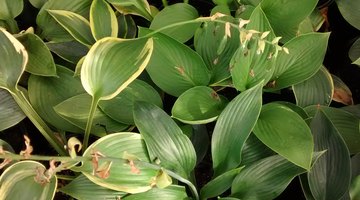How to Prevent Bugs From Eating Hosta Plants
Dramatic hostas (Hosta spp.) add vivid green color and bold texture to your yard. These versatile perennials grow in U.S. Department of Agriculture plant hardiness zones 4a through 9a in shady, partially shady or partially sunny areas.

Though fairly easy to grow, hosta plants do sometimes fall victim to certain insects and other pests. For example, earwigs and cutworms can nibble holes in the leaves of your hostas. Insecticides aren't a good choice for hosta pests; cultural controls are usually the most effective.
Things You Will Need
- Empty shallow tin cans
- Vegetable oil
- Bacon grease
- Flashlight
- Gardening gloves (optional)
- Plastic bag
- Peat, manure or compost
- Trowel
- Flower pots or pieces of board
- Dish soap
Eradicating Earwigs
-
Fill clean, empty shallow tin cans with a 1/2-inch layer of vegetable oil.
-
Add a drop or two of bacon grease to the vegetable oil.
-
Bury the cans in the soil around the hostas so the rims of the cans are even with the surface of the ground.
-
Check the traps regularly, dump out the oil and earwigs inside, refill the cans and place them back in their spots around the hostas.




Kick Cutworms to the Curb
-
Take a flashlight outside after dark and carefully check your hosta plants for cutworms, which are 1- to 2-inch-long, brown caterpillarlike pests. Check under each hosta leaf, as well, as cutworms aren't picky about which side of the leaf they're eating.
-
Pluck each cutworm that you find off the leaves of your plants using your fingers. Wear gloves if you prefer.
-
Put the cutworms in a plastic bag and throw them in the trash so the pests can't make their way back to your hostas.



Nix the Nematodes
-
Place a layer of peat, manure or compost on the soil surrounding your hostas. These natural ingredients increase the moisture level around your plants, which is effective because nematodes tend to target plants that haven't been getting enough water.
-
Mix the peat, manure or compost into the soil, using a trowel to dig underneath the existing soil and turning it to mix the new materials in.
-
Water the area around your hostas well to further incorporate the peat, manure or compost into the soil.



Stop the Snails and Slugs
-
Place overturned flower pots or pieces of board in the area where your hosta plants are growing.
-
Check underneath the flower pots or boards each day for slugs or snails. Remove any pests you find. Wear gloves if you wish.
-
Put the snails or slugs in plastic bags and throw them in the trash so they don't return to your plants.



Tip
You can also throw the cutworms, slugs and snails in a bucket of soapy water to kill them.
The Drip Cap
- Dramatic hostas (Hosta spp.) Wear gloves if you prefer.
- Put the cutworms in a plastic bag and throw them in the trash so the pests can't make their way back to your hostas.
- Place overturned flower pots or pieces of board in the area where your hosta plants are growing.
References
- National Gardening Association: Hosta
- University of California Statewide Integrated Pest Management Program: Earwigs
- University of California Statewide Integrated Pest Management Program: Cutworms
- University of California Statewide Integrated Pest Management Program: Nematodes
- University of California Statewide Integrated Pest Management Program: Snails and Slugs
Writer Bio
Sara Ipatenco has taught writing, health and nutrition. She started writing in 2007 and has been published in Teaching Tolerance magazine. Ipatenco holds a bachelor's degree and a master's degree in education, both from the University of Denver.
Photo Credits
- Jeanne Studio/Demand Media
- Jeanne Studio/Demand Media
- Jeanne Studio/Demand Media
- Jeanne Studio/Demand Media
- Jeanne Studio/Demand Media
- Jeanne Studio/Demand Media
- Jeanne Studio/Demand Media
- Jeanne Studio/Demand Media
- Jeanne Studio/Demand Media
- Jeanne Studio/Demand Media
- Jeanne Studio/Demand Media
- Jeanne Studio/Demand Media
- Jeanne Studio/Demand Media
- Jeanne Studio/Demand Media
- Jeanne Studio/Demand Media
More Articles



